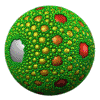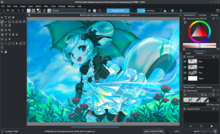
In computer graphics and digital photography, a raster graphic represents a two-dimensional picture as a rectangular matrix or grid of pixels, viewable via a computer display, paper, or other display medium. A raster is technically characterized by the width and height of the image in pixels and by the number of bits per pixel. Raster images are stored in image files with varying dissemination, production, generation, and acquisition formats.

Vector graphics are a form of computer graphics in which visual images are created directly from geometric shapes defined on a Cartesian plane, such as points, lines, curves and polygons. The associated mechanisms may include vector display and printing hardware, vector data models and file formats, as well as the software based on these data models. Vector graphics is an alternative to raster or bitmap graphics, with each having advantages and disadvantages in specific situations.

2D computer graphics is the computer-based generation of digital images—mostly from two-dimensional models and by techniques specific to them. It may refer to the branch of computer science that comprises such techniques or to the models themselves.

A vector graphic editor is a computer program that enables its users to create, compose and edit images with the use of mathematical and geometrical commands rather than individual pixels. This software is used in creating high-definition vector graphic images that can be scaled indefinitely without losing their quality. The output is saved in vector graphic formats, such as EPS, PDF, WMF, SVG, or VML.

A raster image processor (RIP) is a component used in a printing system which produces a raster image also known as a bitmap. Such a bitmap is used by a later stage of the printing system to produce the printed output. The input may be a page description in a high-level page description language such as PostScript, PDF, or XPS. The input can also be or include bitmaps of higher or lower resolution than the output device, which the RIP resizes using an image scaling algorithm.
CodedColor is a bitmap graphics editor and image organizer for computers running the Microsoft Windows operating system, and is published by 1STEIN.

Transparency in computer graphics is possible in a number of file formats. The term "transparency" is used in various ways by different people, but at its simplest there is "full transparency" i.e. something that is completely invisible. Only part of a graphic should be fully transparent, or there would be nothing to see. More complex is "partial transparency" or "translucency" where the effect is achieved that a graphic is partially transparent in the same way as colored glass. Since ultimately a printed page or computer or television screen can only be one color at a point, partial transparency is always simulated at some level by mixing colors. There are many different ways to mix colors, so in some cases transparency is ambiguous.

Clip art is a type of graphic art. Pieces are pre-made images used to illustrate any medium. Today, clip art is used extensively and comes in many forms, both electronic and printed. However, most clip art today is created, distributed, and used in a digital form. Since its inception, clip art has evolved to include a wide variety of content, file formats, illustration styles, and licensing restrictions. It is generally composed exclusively of illustrations, and does not include stock photography.

Digital illustration or computer illustration is the use of digital tools to produce images under the direct manipulation of the artist, usually through a pointing device such as a graphics tablet or, less commonly, a mouse. It is distinguished from computer-generated art, which is produced by a computer using mathematical models created by the artist. It is also distinct from digital manipulation of photographs, in that it is an original construction "from scratch". Photographic elements such as background or texture may be incorporated into such works, but they are not necessarily the primary basis.

In computer graphics, pixelation is caused by displaying a bitmap or a section of a bitmap at such a large size that individual pixels, small single-colored square display elements that comprise the bitmap, are visible. Such an image is said to be pixelated.
A number of vector graphics editors exist for various platforms. Potential users of these editors will make a comparison of vector graphics editors based on factors such as the availability for the user's platform, the software license, the feature set, the merits of the user interface (UI) and the focus of the program. Some programs are more suitable for artistic work while others are better for technical drawings. Another important factor is the application's support of various vector and bitmap image formats for import and export.
An image file format is a file format for a digital image. There are many formats that can be used, such as JPEG, PNG, and GIF. Most formats up until 2022 were for storing 2D images, not 3D ones. The data stored in an image file format may be compressed or uncompressed. If the data is compressed, it may be done so using lossy compression or lossless compression. For graphic design applications, vector formats are often used. Some image file formats support transparency.
In computer graphics, image tracing, raster-to-vector conversion or raster vectorization is the conversion of raster graphics into vector graphics.

Graphic art software is a subclass of application software used for graphic design, multimedia development, stylized image development, technical illustration, general image editing, or simply to access graphic files. Art software uses either raster or vector graphic reading and editing methods to create, edit, and view art.
The following are common definitions related to the machine vision field.

Helicon Filter, also referred to as Helicon, Filter, or as HF, was a proprietary commercial and shareware photo editing software program for Microsoft Windows, similar to such programs as Adobe Photoshop and GIMP, developed and published by Helicon Soft Ltd. Unlike these other programs, Helicon Filter is designed primarily to edit and improve existing photos and not for graphics creation. Helicon Filter's interface also differs from other programs in that compact toolbars and menus containing editing tools are replaced with labeled "filter" tabs, each tab containing labeled edit options specific to a single aspect of the picture. Although some editors used to Photoshop-style programs may initially find this layout unfamiliar and unlike the standard toolbar layout, beginners and those who don't recognize the standard icons generally find this very helpful for getting through the editing process.
In computing, a bitmap is a mapping from some domain to bits. It is also called a bit array or bitmap index.

Image editing encompasses the processes of altering images, whether they are digital photographs, traditional photo-chemical photographs, or illustrations. Traditional analog image editing is known as photo retouching, using tools such as an airbrush to modify photographs or editing illustrations with any traditional art medium. Graphic software programs, which can be broadly grouped into vector graphics editors, raster graphics editors, and 3D modelers, are the primary tools with which a user may manipulate, enhance, and transform images. Many image editing programs are also used to render or create computer art from scratch. The term "image editing" usually refers only to the editing of 2D images, not 3D ones.
Paintbrush is a raster graphics editor for Mac OS X. It aims to replace MacPaint, an image editor for the classic Mac OS last released in 1988. It also is an alternative to Microsoft Paint. It has basic raster image editing capabilities and a simple interface designed for ease of use. It exports as PNG, JPG, BMP, GIF, and TIFF. The application also is often used for pixel art because of its grid option, and is not made for large scale images or GIMP or Photoshop-like editing on pictures or photographs.
This is a glossary of terms relating to computer graphics.













